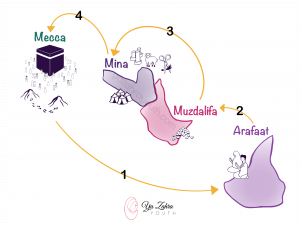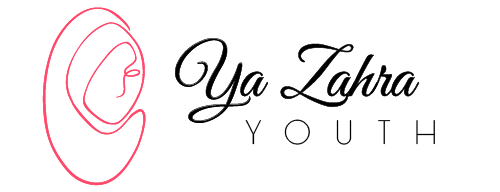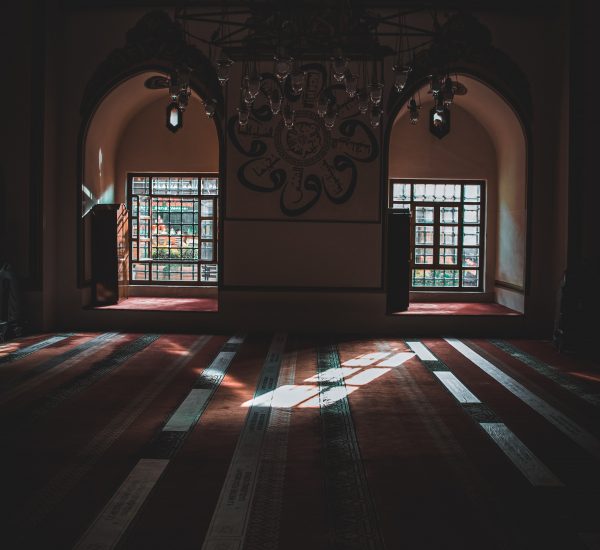What is Hajj?
Hajj (pilgrimage) is an act of worship which is obligatory upon a Muslim once in their lifetime, if they meet all the conditions for Hajj to become obligatory upon them. Hajj takes place each year in the holy city of Mecca on the 9th, 10th and 11th of Zhul-Hijjah. It should be performed as soon as it becomes obligatory, and should not be delayed.
Hajj in the Holy Quran
Allah states in the holy Quran:
وَلِلَّـهِ عَلَى النَّاسِ حِجُّ الْبَيْتِ مَنِ اسْتَطَاعَ إِلَيْهِ سَبِيلًا ۚ وَمَن كَفَرَ فَإِنَّ اللَّـهَ غَنِيٌّ عَنِ الْعَالَمِينَ …
“…And it is the duty of mankind toward Allah to make pilgrimage to the House—for those who can afford the journey to it—and should anyone renege [on his obligation], Allah is indeed without need of the creatures.” (3:97)
To understand the following text, it may be helpful to refer to the Hajj Vocabulary page:
Hajj VocabularyConditions that make Hajj Obligatory
The following is a list of conditions that make one a Mustati:
- Maturity (Hajj is not obligatory before the age of bulugh)
- Sanity
- Financial capability to travel and perform Hajj
- Physical health
- Safety
- Sufficient time
Steps of Hajj
The following is a brief overview of the steps of Hajj, in order to help get an overall understanding for someone new to the concept of Hajj. Each step has its own rules and may vary depending on the situation of the Haji. For more detailed information, one should refer to books about Hajj, or specific rules written by their Marja-e-Taqlid:

Figure: Hajj
The Hajj consists of 2 main parts:
- Performing Umrah when reaching the holy city of Mecca. This Umrah can be performed anytime before the 9th of Dhul-Hijjah.Umrah: An Umrah is act of worship that consists of Ihram, Tawaf, Prayer of Tawaf, Saai, and Taqseer. An Umrah can be performed anytime of the year, however that Umrah will not be part of Hajj. The Umrah for Hajj is a part of the Hajj journey and must have the intention of Umrah for Hajj.
- Tasks that must be performed on specific dates:
-
9th:
Ihram of Hajj: Wearing the Ihram of Hajj (on or before the 9th of Dhul-Hijjah)
Wuqoof-e-Arafat: Stay in the plain of Arafat on 9th of Dhul-Hijjah from Zuhr till Maghrib -
10th:
Wuqoof-e-Muzdalifa/Mashar-al-Haram: Spend the night before 10th of Dhul-hijjah in Muzdalifa (also known as Mashar-al-Haram) and collect pebels
Jamarat-al-Aqaba: Stoning of the big shaitan in Mina on the 10th of Dhul-Hijjah
Qurbani: Sacrificing an animal
Halq or Taqseer: Shaving the head for men or cutting a small amount of hair or nails for women (This ends the state of Ihram) -
11th:
Wuqoof-e-Mina: Staying the night before 11th of Dhul-Hijjah in Mina
Rami-Jamarat: Stoning all three “shaitans” on the day of 11th of Dhul-Hijjah -
12th:
Wuqoof-e-Mina: Staying the night before 12th of Dhul-Hijjah in Mina
Leaving Mina before Zuhr (otherwise 1 more night must be spent in Mina)3. -
Anytime from 10th Zhul-Hijja onwards these tasks must be performed in Mecca:
- Tawaf of Hajj and 2 unit Prayer of Tawaf
- Saai (Going between Safa and Marwa 7 times)
- Tawaf-un-Nisa and 2 unit Prayer of Tawaf
-




